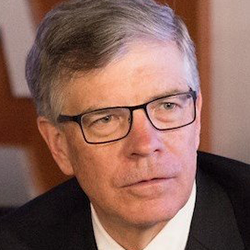28 Learning Features with Jeff Trimble
Jeff Trimble was an international journalist, editor and media manager for more than 35 years before joining the Ohio State faculty.

What were your biggest initial struggles/challenges with writing features?
Getting the balance right between facts and the detail and nuance that draw and hold the attention of readers.
As opposed to factual news writing, I tended to include so much “color” in feature writing that it was difficult to sustain the narrative thread. I tended to throw in all the color detail I had in an effort to making copy “interesting,” rather than using the best such details to help reinforce essential elements.
I also tended to use quotes that were redundant and did not add value to the narrative.
How have you worked through them and what advice do you offer students to do the same?
Good editors are essential. The best ones were present throughout the reporting and writing process, with the result being clean, smart copy that met their expectations; the worst ones made or approved the assignment, waited for the copy to land, and then rewrote to suit their preferences.
It also helped me to read a LOT of good feature writing by journalists of my generation as well as those of previous generations.
What are some examples of where features went well or went badly, and what did you learn?
Often in my career as a foreign correspondent, I only got one shot, one opportunity, to interview or speak with key players as I worked on longer features. Sometimes these interactions were brief or happened spontaneously, such as catching a senior government official in a corridor for a few minutes.
The better prepared I was for such encounters, the more successful they were. Lesson: Do your homework and then do it again before heading into the field to report.
In many cases, you’ll be able to review your interview notes and follow up with sources to clarify or expand on points made. But don’t assume this will be the case!
Can you provide a specific story experience where your growth in the genre showed?
As a correspondent in Moscow during the tumultuous final years of the Soviet Union, I often found myself in crowded situations, trying to get exclusive comments or other material from officials, dissidents and others who were in constant demand by the global media.
After repeated scenes of jostling and even trying to outshout colleagues, I learned an important lesson: patience. I realized that it made more sense to build relationships over time with officials and other sources. Rather than trying to be the first to get a quote, I endeavored to seek relationships that ultimately resulted in comments and information that was richer and more substantive.
I made use of this technique in December 1986 when Soviet physicist and dissident Andrei Sakharov was allowed to return to Moscow from internal exile. Rather than fighting the crowd that met Sakharov as he got off the train, I sought out Yelena Bonner, Sakharov’s spouse and also a noted dissident, as she stepped onto the platform.
I had taken time to get to know Bonner, who unlike Sakharov was allowed to travel freely. I spoke with her, untroubled by other reporters, for 10 minutes or so. This resulted in a private invitation to Sakharov’s Moscow apartment the next day.
Over tea and cookies I conducted an exclusive 30-minute interview that formed that basis of a successful feature.
Any other advice you’d like to add?
Think carefully about quotes in feature writing. Quotes should not restate points already made in the narrative; they need to add unique value to move the story forward, or at very least to introduce a new thought or topic rather than to restate points already made.
Don’t quote someone just to prove the fact that you actually did the interview!
